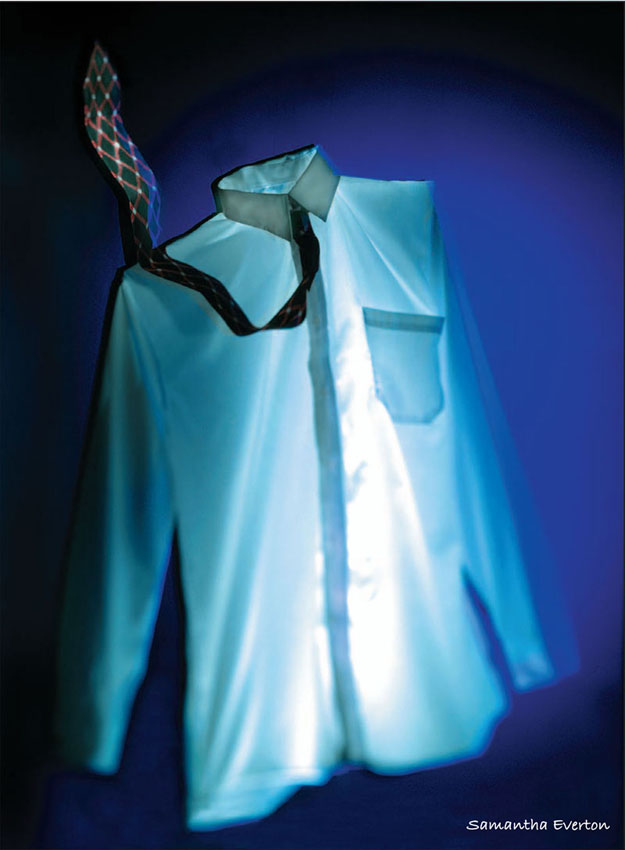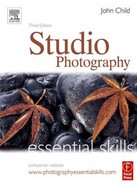using light
essential skills
~ A knowledge and understanding of the use of artificial light sources, camera and associated equipment in a studio environment.
~ An awareness of the effect of artificial light in the creation and control of lighting ratios, tonal range, contrast and exposure.
~ Through research the study and observation of the use of light in the production of photographic images.
~ The production of photographic images demonstrating a practical knowledge of the use of light.
~ Record information relevant to the technique and production of each photograph.
Shaun Guest
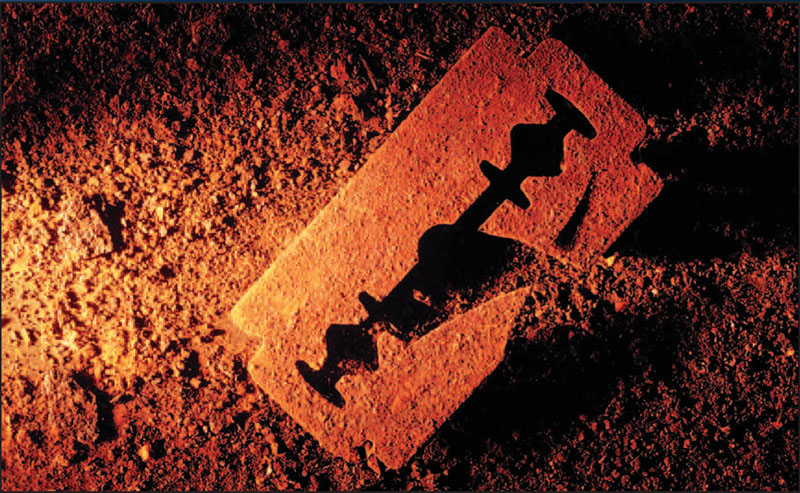
Introduction
This study guide should be used as a practical source of information to understanding the use of artificial light sources in a studio environment. The explanation of how to use the light sources (diffuse and direct) is directly related to providing practical lighting solutions to the assignments in ‘Lighting Still Life’ and ‘Assignments’. Completion of the activities will provide a basis for an understanding of the recommended approach to each assignment. It is advisable the technique and lighting approach suggested in each activity be initially followed and then adapted to individual subject matter.
Ricky Bond
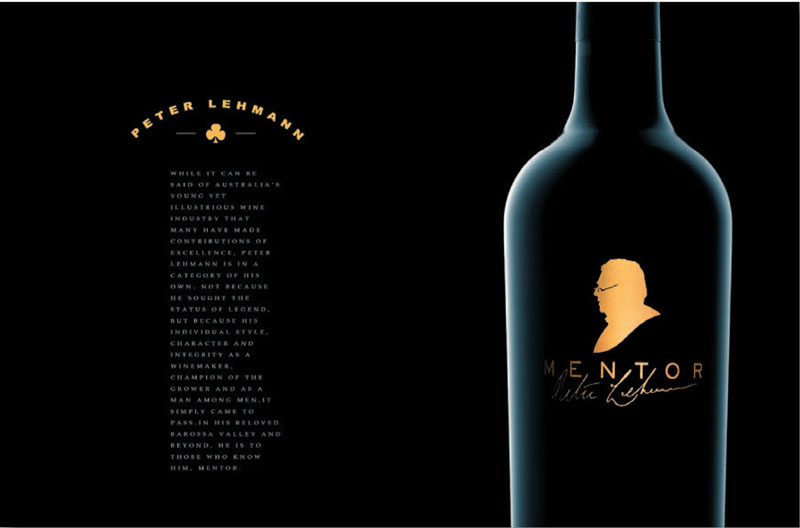
Approach
The sun, the dominant light source in the world outside the studio, is the starting point to understanding studio lighting. As you progress through your photographic career other approaches will inevitably influence you but an understanding of how to use a single light source to achieve many varied results is a discipline worth mastering. Try not to attempt too much too soon. Set yourself goals you know you can achieve within your limitations. Aspiring photographers may never have enough time or money but admirably they are exploding with ideas. It is making these ideas work within these constraints and abilities that will give successful results. Set out to achieve what you know is possible, take as much time as is available and exercise patience. If you allow three hours to produce an image use the full three hours. When you have completed the photograph experiment with variations. Every time you move a light or alter its quality you will learn something. You will never take the perfect photograph. If you ever think you have change careers because photographically the learning process has ceased.
Working with studio lights
Common rules
Common rules of physics apply to the use of artificial light sources. When sunlight passes through greater amounts of particles in the atmosphere at dawn or sunset, exposure times increase compared to a reading taken at noon. This applies to clear and overcast days. Exposure times will obviously be shorter on a clear day. Applying these rules to a studio situation, the greater the impedance to the light (diffusion, reflection, filtration) the longer the exposure. The less impedance to the light (no diffusion, reflection, filtration) the shorter the exposure.
Another simple rule. The amount of light falling on a subject decreases to 1/4 of its original intensity when the light to subject distance is doubled, and increases by four times when the light to subject distance is halved. For example, if a reading of f16 is obtained when the light to subject distance is one metre, at two metres the reading would be f8, at four metres f4. These rules do not change regardless of the light source. It is also important to remember contrast in a studio situation is created not only by the reflectance level of the subject matter (SBR) but also by lighting ratios. When referring to lighting ratios the photographer is also referring to lighting contrast. See ‘Light’.
Key light one metre from subject
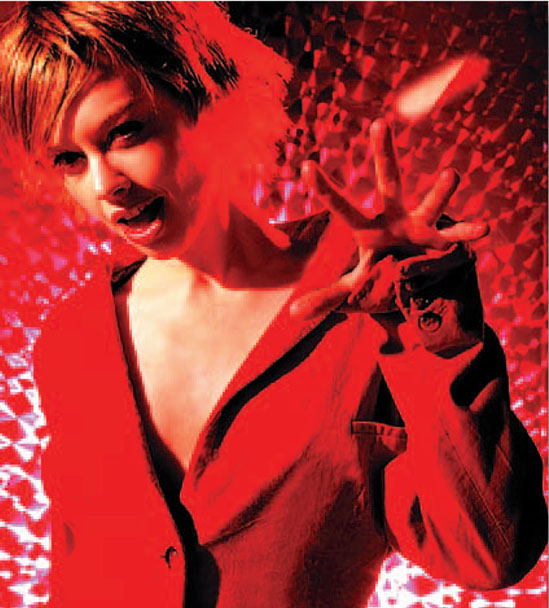
Key light two metres from subject - Fabio Sarraff
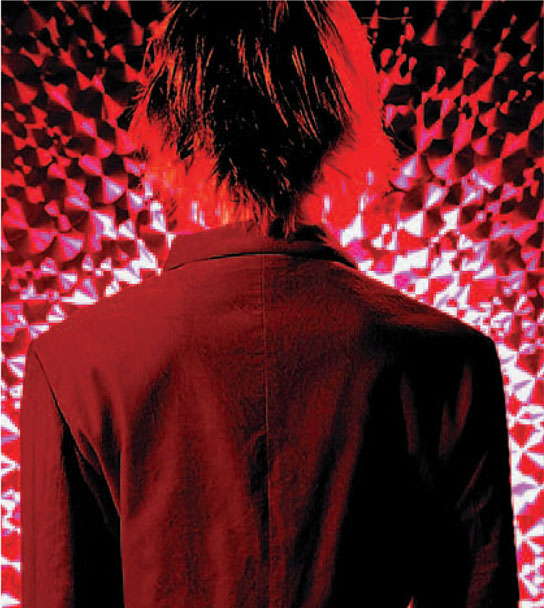
ACTIVITY 1
In a darkened studio place a light one metre from the studio wall and take an incident reading, with the light on, of the light falling upon the wall. Note the reading and move the light on the same axis another one metre, making a total of two metres, away from the wall. Note the reading. Double the distance once more, making a total of four metres. The final reading will be four stops less than the first. What will the distance of the light from the wall have to be to achieve a meter reading of three stops less than the first?
Flash
Flash is a generic term referring to an artificial light source of high intensity and short duration. It has a colour temperature of 5500K-5800K and is compatible with daylight colour film and any black and white film. Unlike tungsten it is not a continuous source of light. Between flashes it has to recycle (recharge) to maximum output before it can be used. A large tungsten lamp has an output 100 times greater than the average household light bulb. With a film or image sensor rated at ISO 100 this will give exposures of around 1/60 second at f4. A modest studio flash with an output of 5000 joules (measurement of output) at the same distance from the subject will give exposures of around 1/500 second at f11. This is six stops faster or a ratio of 64:1. Its advantage with subject matter that moves becomes obvious.
Stuart Wilson
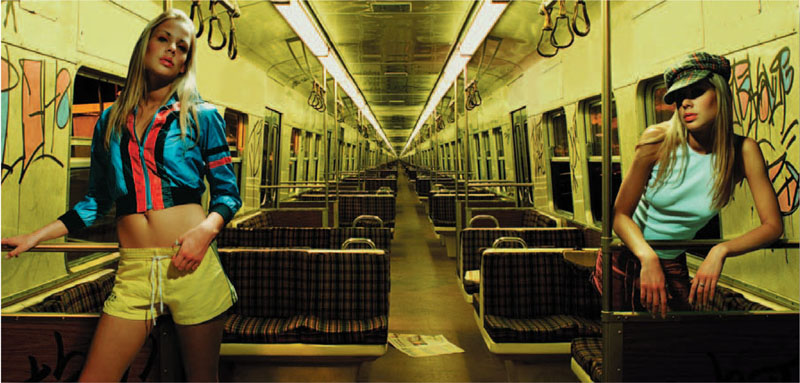
The advantage of modern flash is its lightweight construction and versatility. Most studio flash systems consist of the power pack, flash heads and flash head attachments. The power pack is usually a separate unit where the power output is stored until the instant of exposure. After exposure the power pack recharges ready for the next exposure. Recycling times vary from seconds to fractions of a second. The faster the recharge to full power the more expensive the unit. The flash heads are the actual light source. The basis of their design is to produce a light quality similar to that produced by floodlights and spotlights. The way in which this is achieved ranges from varying sizes of reflector bowls similar in design to a floodlight, to a focusing spotlight equivalent to its tungsten counterpart. The choice of flash head attachments manufactured to achieve this is extensive and varied. A large percentage of the images in this book were lit using studio flash. This is not to underestimate the importance of tungsten in a studio situation. Flash, being a non-continuous light source, is confined to ‘still’ photography whereas tungsten lighting is used almost exclusively in ‘moving’ photography (film, video and TV). However, the lessons learned with one light source apply equally to any other.
Floodlight
Despite the manufacturers’ names, swimming pool, soft box, fish fryer, honeycomb and many others, these are really only larger or smaller variations of a floodlight. In some the light source is placed inside and to the rear of a collapsible tent with direct light transmitted through a diffuse front surface. In others the light is reflected off a white or silver surface before it is transmitted through a diffuse front surface. These types of light sources give a very soft diffuse light with minimum shadows. Another source of soft diffuse light is created when flash is used in conjunction with a collapsible umbrella. With umbrellas having a white or silver (inside) surface, diffuse light with no shadows can be directed into the umbrella and reflected back onto the subject. With umbrellas having a semi-transparent surface, diffuse light with soft shadows can be directed at the subject through the umbrella.
Soft box
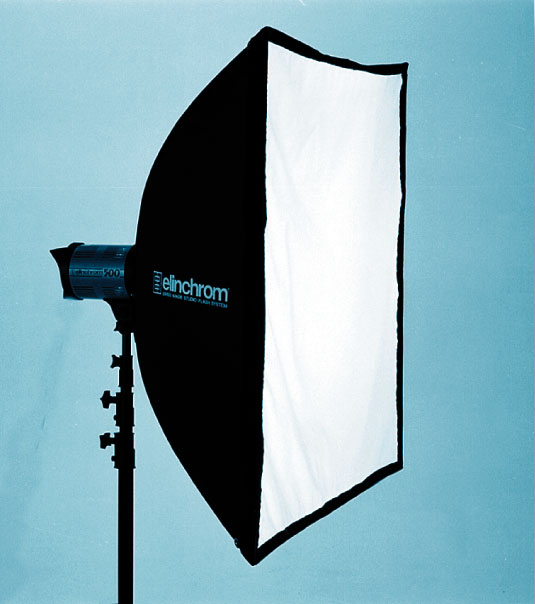
Reflected umbrella
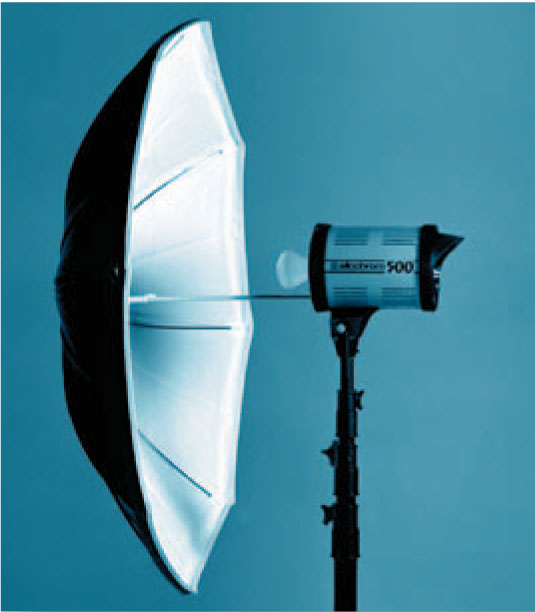
Diffuse umbrella

Spotlight
The use of an open flash (direct light to subject without diffusion or reflection) will give the same effect as a spotlight. Some brands have focusing capabilities closely imitating Fresnel spotlights. The light will be hard with no shadow detail. Barn doors, nets and filtration of the light is approached in the same way with either artificial light source.
Stuart Wilson

Tungsten
Vacuum tungsten lamps and their derivatives are widely used forms of artificial photographic lighting in photography, film and television. They have a colour temperature between 3200K and 3400K and are compatible with correctly balanced image sensors, tungsten colour film and black and white film. See ‘Image Capture’. Despite the extensive use of flash in a commercial studio, prior to any flash exposure the way a subject is lit is usually determined by the use of tungsten modelling lamps built into the flash heads. Flash gives a much shorter exposure time with a similar quality of light to the same subject having been lit by an appropriate tungsten light source. However, compared to flash, tungsten is relatively simple technology. It should be taken into account when learning the use of tungsten lighting that all film and television lighting is tungsten based. There are many variations to the lighting sources available but in general terms they all fall into the two major categories, floodlight and spotlight.
Floodlight
A floodlight produces a wide flood of light across a subject. The light from the lamp bounces off the reflector in which it sits and travels forward as a broad light source. This diffuse light gives ‘soft’ edges to the shadows and some shadow detail. The quality of the light is similar to sunlight through light cloud.
Floodlight
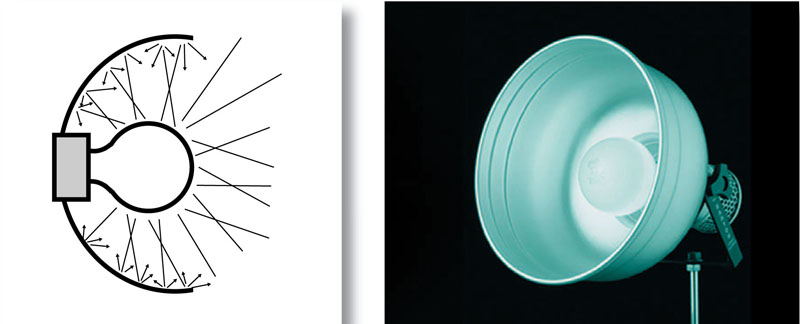
ACTIVITY 2
In a darkened studio place a diffuse flash or tungsten floodlight four metres in front of a person standing against the wall. Turn on the light. Note the lack of shadow detail.
Without moving the light get the person to move one metre away from the wall. Note the increase in shadow detail and softening of the shadows’ edges.
Repeat in one metre increments until the subject is almost in front of the light.
What is happening to the shadows and why?
Compile results in your Record Book.
Spotlight
A spotlight, by use of a focusing (Fresnel) lens, can concentrate light at a certain point. The light from the lamp is directed forward by a spherical reflector and focused to a point by the glass Fresnel lens. The light will have ‘hard’ edges to the shadows and no detail in the shadow areas. The quality of the light is similar to direct sunlight. Spotlights can be ‘flooded’ to give a more diffuse quality comparable to the spread of a floodlight but with less shadow detail. This change from spot to flood is achieved by moving the lamp and the reflector inside the lamp housing away from (spot) or closer to (flood) the lens at the front of the light. On ‘full spot’ shadows are harsh with no detail, on ‘full flood’ shadows are softer with some detail.
Full flood/full spot
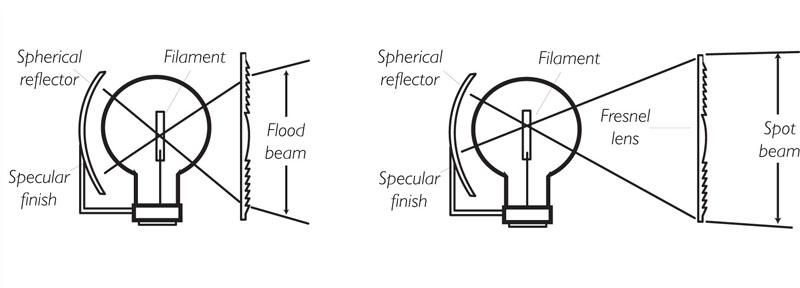
Most spotlights are supplied with barn doors and nets. Barn doors are four metal flaps attached to the front of the light and used to control the shape and amount of light falling on the subject. Narrowing the doors will not only reduce the amount of light but also control the shape of the light falling on the subject. Once shaped the barn doors can be rotated independently of the main light housing. Nets are pieces of wire gauze of varying densities that reduce the output of the light by diffusing the light at its source without greatly affecting the shadows. They are manufactured in half and one stop increments.
ACTIVITY 3
In a darkened studio light a subject (a person) with a diffuse flash or tungsten floodlight from the right-hand side.
Record with correct exposure for the lit side of the face.
Turn off the light and relight the same subject from the same direction with an open flash or tungsten spotlight on ‘full spot’.
Record with correct exposure for the lit side of the face.
Observe the results and determine the difference in the intensity and detail in the shadows.
Which light would you use for no shadow detail and which light for limited shadow detail?
Compile results in your Record Book.
Diffusion
Long before the invention of photography painters had been diffusing light. Light passing through certain materials created a light with soft shadows sympathetic to their subjects. Early writings and drawings of Michelangelo show his studio had a type of cheesecloth hung over the windows. This diffused the harsh sunlight and filled the studio with a soft light more suitable to painting. Any light source can be diffused by placing certain translucent materials between the light source and the subject. This has the effect of diffusing and spreading the light over a greater area by altering the direction of the light waves. Diffusion softens the edges of the shadows and increases shadow detail. At the same time the measured amount of light falling on the subject is decreased. The amount of diffusion is also determined by where the diffusion material is placed in relation to the light source and the subject. The closer the diffusing material to the light source the less diffuse the light. The closer the diffusing material to the subject the more diffuse the light, the softer the edges of the shadows and the greater the shadow detail. There are many diffusion products manufactured specifically for the photographic market. These are products such as scrim, nets, and silks. Other suitable materials are tracing paper, cheesecloth, and window netting provided they are non-flammable or heat-proof.
Diffuse light - Itti Karuson
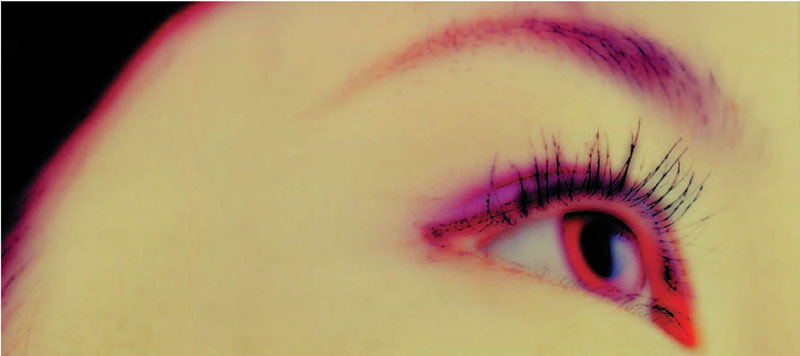
ACTIVITY 4
In a darkened studio light a semi-reflective object (e.g. a tomato) with an open flash or tungsten spotlight. Place the light approximately 1.5 metres from the subject.
Observe the source of light reflected in the object and lack of shadow detail.
Diffuse the light source with tracing paper (60cm x 60cm) 50cm from the light.
Observe the apparent increase in the size and diffusion of the light source as reflected in the subject, diffusion of the shadows and increase in shadow detail.
Without moving the light place the tracing paper as close to the subject as possible.
The light source has now become the size of the piece of tracing paper. There will be a soft spread of light over most of the subject with the shadow being almost nonexistent.
Reflection
Reflected light is most often used as a way of lighting areas the dominant light source (key light) cannot reach. An example is the strong shadow created by a spotlight when it is to one side of the subject. To obtain detail in the shadow area light has to be reflected into the shadows. This is called fill light and is achieved by collecting direct light from the light source and redirecting it with a reflector. Reflectors can be any size, from a very small mirror to large polystyrene sheets measuring 3m x 1.5m. Reflected light can also be used as the key light. When photographing a reflective object, or a very diffuse (soft) lighting effect is required, the light source can be directed into a reflector. The reflector becomes the light source and no direct light from the light source is directed at or reflected in the subject. When photographing cars in an exterior situation the car is usually positioned so sunrise or sunset is behind the car. With the sun below the horizon, the sky above and in front of the car is acting as a giant reflector. This is one approach to lighting cars and reflective objects in a studio. There are many reflective products manufactured specifically for the photographic market. More readily available materials are, white card, grey card, coloured card, silver foil, aluminium foil, and mirrors.
Reflector as light source - Ricky Bond
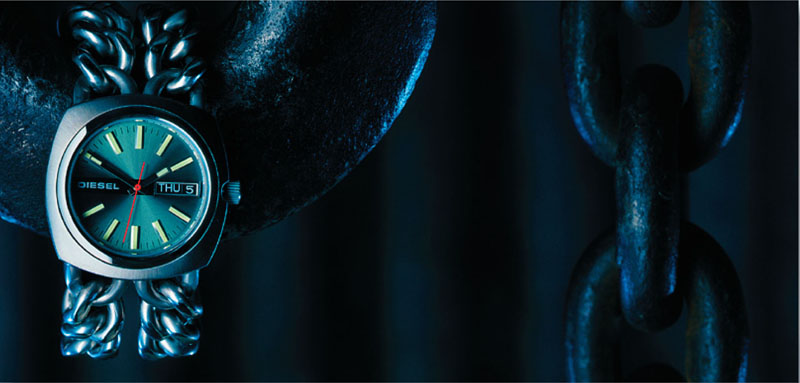
ACTIVITY 5
Light a person’s face with open flash or tungsten spotlight from behind and to one side.
Observe the deep shadows falling across most of the face.
Using a reflector (white card 1m x 1m) redirect the light into the shadow areas.
Observe how the intensity of the light changes as the reflector is moved closer to and further away from the face.
Expose image at the desired intensity of fill.
Cover the reflector with aluminium foil and repeat the above activity.
Label and keep results for future reference.
Compile results in your Record Book.
Filtration
Filters alter the quality of light by selectively transmitting certain colours or by changing the way light is transmitted. A red filter only transmits red light. A blue filter only transmits blue light and so on. A soft focus filter changes the direction of the light waves in the same way as diffusion material softens a light source. Correction filters alter the colour temperature of the light to make it compatible with the film being used. Neutral density filters reduce the amount of light, and therefore exposure, from a light source without affecting its colour temperature. Glass, plastic and gelatin filters are used for filtration of the camera lens but gelatin filters are used more often in the filtration of the light source. The advantage of filtering the light source is that different filters can be used on each of the lights whereas with filtering the camera all light entering the lens will be subjected to a common filter. Filters used upon a light source are made of heat resistant coloured gels manufactured to specific safety requirements and colour balance. The effect of filtration is obvious and immediate. When working with correctly colour balanced gels, appropriately balanced film or image sensor and correct exposure ‘what you see is what you get’. When using colour filtration with black and white film a simple way of remembering the affect of a certain filter is that it will lighten its own colour and darken all others. Filtration of the camera is normally used for colour correction of the entire image. This may be caused by the light source being incompatible with the film or to remove an excess of one colour inherent in the light source. However, when capturing RAW file images it is possible to undertake colour correction in post production. See ‘Image Capture’.
Polarising filters are valuable in the control of unwanted reflections and increased colour saturation. This is because of their ability to selectively transmit certain wavelengths as they are rotated in front of the camera lens or light source. A wide range of ‘effect filters’ such as graduated and star burst are also available for on camera use and post production software. They can produce some interesting results but should not be used as a substitute for the lack of an original idea or solution to a photographic problem. With camera filtration there will always be some degree of exposure compensation.
Post produced filtration - Stuart Wilson
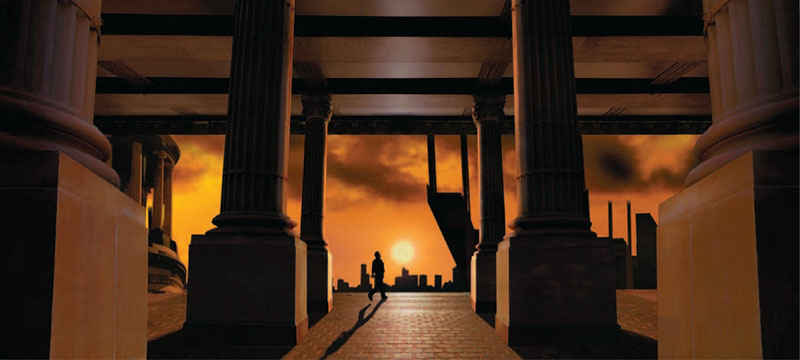
Mixed light sources
Any source of light can be combined with another to create interesting lighting effects and shifts in colour balance. In a studio situation this can go beyond mixing tungsten with flash and is limited only by one’s imagination. Normal domestic lamps are often used as supplementary and practical sources of light. Candles give a warm glow and very soft shadows. Torch light can be used to great effect when painting with light. When working in colour do not be afraid to change the colour of the light by the use of coloured gels on the lights, or on the camera or incorrect white balance. If it gives off light, try using it!
Mixed flash and tungsten - Amelia Soegijono
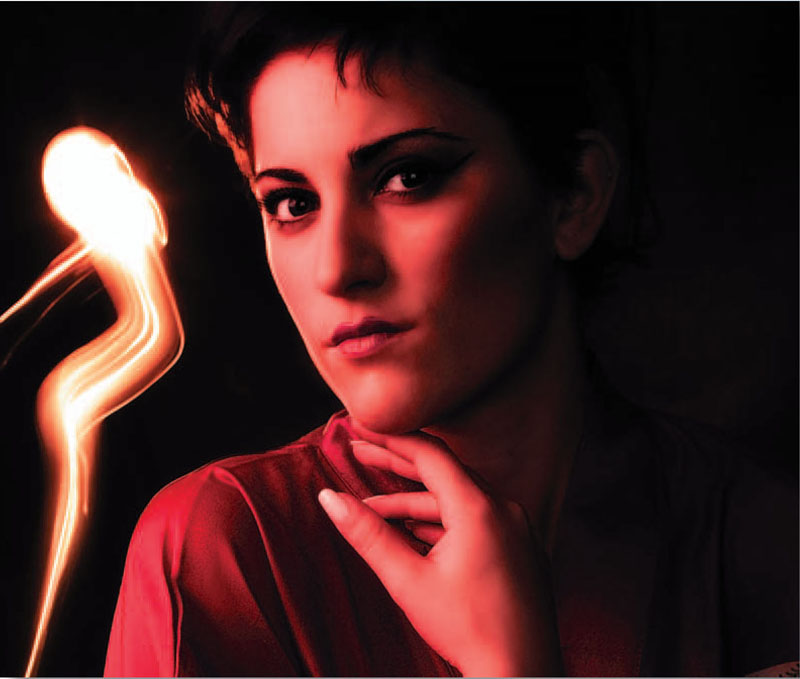
ACTIVITY 6
Place a camera on a tripod. Focus on a coin placed on a dark background. Set the shutter speed to T (the aperture opens when activated and will not close until activated for the second time).
Set the aperture to maximum aperture. Darken the studio and open the lens. Using a small torch move its light over the coin as if painting with a brush (large broad strokes) for approximately 10 seconds. This should be done from the camera position.
Bracket your exposures by one stop either side of normal (5 seconds and 20 seconds).
Repeat this procedure at every f-stop. Record results and observations.
Illusion of movement
Closely associated with an understanding of the use of light is the use of the camera to create the illusion of movement. By combining the movement of either the camera, subject, or lights the illusion of movement within a still frame can be created. Using tungsten light in a darkened studio and with the camera lens open, walking slowly through frame (the camera’s field of view) will result in a blurred image where you were moving and still image where you stopped. Another way to create movement is to increase exposure time to the longest possible with the light source you are using and move the camera during all or part of the exposure. This is easily achieved with a zoom lens, but also achievable by panning or tilting the camera mounted on a tripod. There other advantages to using a slow shutter speed when using a combination of flash and tungsten. If the output of the modelling lamps, or supplementary tungsten lighting, is high enough to equal the exposure aperture of the flash output a slower exposure time can be used for the tungsten light than required for the flash. This would allow correct exposure of the flash (which is regulated by aperture and not time) and correct exposure of the tungsten (which is regulated by a combination of aperture and time). This would give the effect when using daylight film of a warm after-glow to any object moving before or after the flash exposure.
Camera movement - Itti Karuson
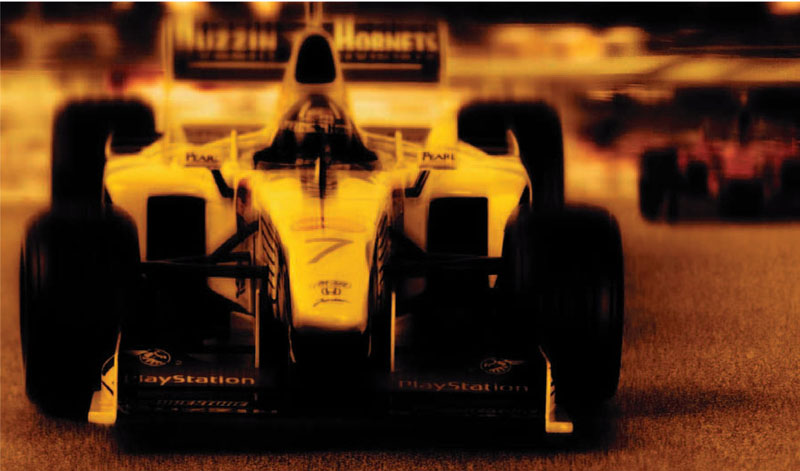
ACTIVITY 7
From the camera position light a person with a broad diffuse tungsten light source.
Set the camera shutter to the longest exposure possible relative to the aperture.
In a darkened studio with the lens open get the subject to walk around in frame.
Vary the speed and rhythm of the movement.
Process and compile results and observations in your Record Book.

